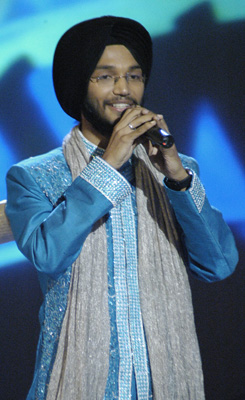
Since May of this year a competition has raged throughout the Indian subcontinent. On Saturday November 24th, 2007, the results were in…the 1st Amul Star Voice of India: Ishmeet Singh from Ludhiana.
 For those in the diaspora, who flip past the ZeeTV, Sony and all those other station as they channel surf, Amul Star Voice of India (SVOI) is the desi version of American Idol. After auditions throughout India, competitors are selected by the judges only to be later subjected to audience voting. Television viewers submitted text messages and finally after six months a winner was chosen.
For those in the diaspora, who flip past the ZeeTV, Sony and all those other station as they channel surf, Amul Star Voice of India (SVOI) is the desi version of American Idol. After auditions throughout India, competitors are selected by the judges only to be later subjected to audience voting. Television viewers submitted text messages and finally after six months a winner was chosen.
The famed Lata Mangeshkar declared Ishmeet Singh from Ludhiana, Punjab the winner. However, the win was far from guaranteed. The runner-up from Uttar Pradesh, Harshit Saxena, had been much more popular by the voters from the West Zone (60% of the votes), East Zone (52% of the votes), and the South Zone (55% of the votes). However, the winner of the competition was not to be decided on the number of winning zones, but rather the gross total. It was here that the Punjab factor kicked in and propelled Ishmeet Singh to victory.
While the blogosphere and message boards are aflame about the results, my purpose here isn’t to engage on the merits of the Ishmeet’s voice or the fairness of the competition methodology. However, the results do bring to the forefront a number of different issues.
An important result of the competition is to highlight Punjab’s ‘tele-density’. Prior to the announcement of the SVOI winner, many members of the interviewed Indian public lamented that Ishmeet would be catapulted to victory based on the fact that while the national telephone per capita is 1:5, in Punjab it is almost double at 1:2. Their gloomy predictions proved correct. The sheer numbers of SMS text messages aided Ishmeet in his victory. While Punjab’s population will never give it a seat at the Lok Sabha and the national stage, its economic and telecommunication power gave it leverage in this competition. Are there other uses for such technology? The Dera Sacha Sauda incident earlier in the year also shows telecommunications powerful ability as a political tool to rally youth support and attendance. Grassroots movements will have to be able to employ this tool to mobilize the Sikh youth and will have to figure out new ways to utilize its tremendous capabilities.
Waheguru Ji Ka Khalsa
Waheguru Ji Ki Fateh
Welcome to The Langar Hall. This is a space dedicated to the experiences, reflections, and interests of a diverse group of young individuals – tied together by our common and varied identities as Sikhs in the diaspora.
Like the many conversations that take place in langar halls around the globe, our blog posts will sweep across a gamut of topics from Gurbani and Seva to Bhangra and Politics. We challenge ourselves to address the myriad of issues we face as individuals and as a community through a progressive lens, and reserve the right to rant, muse, and humor.
Do you have questions or the feeling that some things just have not really been explained? Then join our conversations as we untangle complexities, explore grays, or just share things we find interesting and funny.
Let us conversate!
